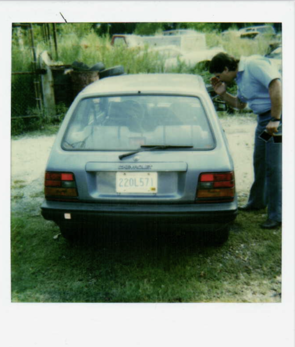My Quest for Evidence and Closure
Reginald Reed Jr.
April 19, 2024

On August 23, 1987, Selonia Reed was found dead in her 1986 Chevrolet Sprint in a vacant lot at a local convenience store in Hammond, Louisiana. Her body was covered in lotion, and she had suffered blunt force trauma to her face, with multiple stab wounds to her body, including an umbrella between her legs.
Selonia Reed is my mother.
The murder remained an unsolved cold case for over 30 years, shrouded in mystery and unanswered questions, until a cigarette butt was DNA tested and found to match an individual who was indicted as a co-defendant. Continuous investigation by law enforcement allowed the pieces of the puzzle to come together, ultimately leading to a shocking revelation—the connection to my own father, Reginald Reed Sr.
Nearly 40 years after the murder, on November 18, 2022, my father was found guilty of second-degree murder and is now serving life in prison for her death.
Writing a Memoir About My Mother’s Murder
Only 6 years old when the crime occurred, I had to rely on my childhood memories while gathering evidence for my memoir about the murder, The Day My Mother Never Came Home. My memories from that time were fragmented and influenced by various factors, including my father’s narrative. My goal was closure, using available resources and corroborating evidence to construct an accurate portrayal of the events leading up to the crime. I also aimed for ethical storytelling based in sensitivity, empathy, and a commitment to truth and justice.

Every crime is a web of interconnected lives, each deserving of understanding and compassion, even in the face of unimaginable tragedy. Unlike a traditional journalism approach that prioritizes objectivity and detachment, my narrative is deeply personal, intertwined with my own emotions, experiences, and relationships. My closeness to the story compelled me to approach it with heightened sensitivity, recognizing the interconnected lives and human complexities behind the crime.
To write a true crime memoir about my mother’s murder, I had to delve into the depths of past events, piece together fragments of information, and unearth long-buried truths. Central to this endeavor was the task of requesting and collecting evidence from various law enforcement agencies, a journey marked by challenges, revelations, and profound shifts in perspective.
The Trail of Evidence in the Murder
Gathering evidence first involved submitting formal requests to relevant law enforcement agencies and speaking with a defense attorney. I had to navigate bureaucratic channels, understand legal protocols, and exercise patience as responses trickled in. Each request was accompanied by a detailed explanation of the information I was seeking, ranging from case files, to witness statements, to forensic reports and investigative notes. I waited for weeks—or even months—for law enforcement agencies to provide information, delaying my research and writing.
As the responses started to trickle in, I immersed myself in a sea of documents, each offering a glimpse into the intricate web of events that shaped the crime. Some documents corroborated what I already knew, providing additional context and depth to key moments in the story. Others, however, unveiled startling revelations and uncovered details that had eluded me until that point.
One startling document revealed several life insurance policies that were taken out over the year leading up to my mother’s death, and a couple that were initiated as soon as two weeks before the murder. This discovery raised suspicions about possible motives and connections to the crime that had not been previously considered. The document not only provided a new angle to the investigation but also highlighted the complexity of the case and the need to dig deeper into the financial aspects surrounding the crime.
I also came across previously undisclosed witness accounts that shed new light on the sequence of events leading up to the murder, challenged existing narratives, and led to a reevaluation of key suspects in the case. One witness provided a detailed description of a vehicle leaving the scene at an unusual hour, contradicting the initial timeline presented by other witnesses.
These discoveries reshaped my understanding of the events and the individuals involved. What I had once perceived as a straightforward narrative became a complex tapestry of intersecting lives, hidden agendas, and unforeseen consequences. It forced me to reevaluate my assumptions, question my interpretations, and embrace the nuances of human behavior in the face of adversity.
Another pivotal moment in the evidence-gathering process was the analysis of forensic reports. I had to familiarize myself with forensic terminology, understand the nuances of forensic analysis, and cross-check facts to ensure accuracy. These reports related to the crime scene, my mother’s injuries, and the potential motives behind the murder, reports that either contradicted or corroborated witness testimonies and suspect statements. I was skeptical when encountering conflicting information or discrepancies between witness testimonies and forensic findings, but the convergence of witness accounts, forensic evidence, and official reports painted a vivid picture of the crime, its aftermath, and the subsequent investigation.

The Emotional Impact of Reading Evidence About My Mother’s Case
As I discovered new information and grappled with its implications, I felt a range of emotions: shock, disbelief, anger, and empathy. The evidence humanized the individuals involved, reminding me of the inherent complexities of human nature and the capacity for both good and evil within us all.
I also encountered conflicting information that challenged my perceptions of my father’s guilt or innocence. Some evidence pointed toward motives or connections that could implicate him, and other information and witness accounts raised doubts or alternative explanations. I realized the need for a comprehensive and unbiased approach to understanding the motives and individuals involved in the crime, without jumping to conclusions or being influenced solely by my emotions or preconceived notions.
The journey of requesting and collecting evidence for my true crime memoir was a transformative experience marked by discovery, introspection, and emotional resonance. It challenged me to confront uncomfortable truths, navigate moral ambiguity, and honor the complexity of human stories. Ultimately, it reinforced my belief in the power of storytelling to illuminate truths, foster empathy, and inspire meaningful change.
Where to Watch the Case
The Selonia Reed case will be covered in an upcoming episode of Fatal Attraction in July 2024 and in Cold Case Files in the spring of 2024.
About the Author
Reginald L. Reed Jr. is an author and an accomplished professional in the pharmaceutical industry. He holds a master’s degree in business and global marketing. In his first book, The Day My Mother Never Came Home, Reed recalls the events surrounding the unsolved murder of his mother and the subsequent indictment and trial of his father, nearly 40 years later. His story will be featured in an episode of Fatal Attraction, releasing July 22, 2024. Visit rlreed.com to learn more.
